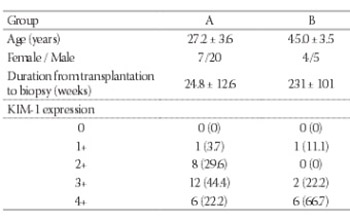Kidney injury molecule-1 expression is closely associated with renal allograft damage
DOI:
https://doi.org/10.17305/bjbms.2013.2357Keywords:
kidney injury molecule-1, renal allograft, biomarkerAbstract
The aim of our study was to investigate the expression of kidney injury molecule-1 (KIM-1) in renal allograft biopsy samples and assess the clinical significance of its use as a biomarker for tissue damage. A total of 69 renal allograft biopsy samples from 17 patients with normal serum creatinine and 52 cases of increased serum creatinine were collected. They were divided into different groups according to the Banff 2007 diagnostic criteria. KIM-1 expression was detected by immunohistochemical methods and the association of KIM-1 and blood biochemical indexes was analyzed. KIM-1 expression increased as Banff 2007 classification grade increased and was positively correlated with tubular inflammation severity in the acute T-cell rejection group. Moreover, KIM-1 expression was strongly positive in the chronic active antibody-mediated rejection group. Interestingly, KIM-1 was weakly positive in the normal group without obvious acute rejection and injury of immunosuppressant toxicity. In this group, 27.3% (3/11) of the cases with normal serum creatinine level showed weakly positive KIM-1 expression in their renal tissues. KIM-1 expression level is positively correlated with renal allograft damage and tubular cell injury. KIM-1 is expressed in tubular epithelial cells before blood biochemical indexes become elevated and morphological changes occur. KIM-1 expression is an early, sensitive, and specific biomarker to determine renal tubular epithelial cell injury in renal allograft tissue.
Citations
Downloads

Downloads
Additional Files
Published
How to Cite
Accepted 2017-08-13
Published 2013-08-20









